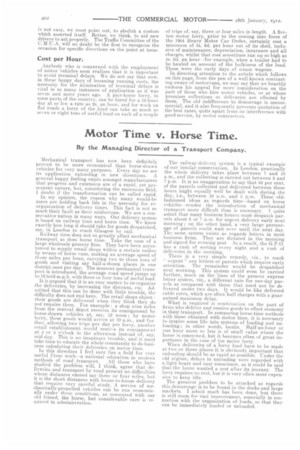Motor Time v. Horse Time.
Page 2

If you've noticed an error in this article please click here to report it so we can fix it.
By the Managing Director of a Transport Company.
Mechanical transport has now been definitely proved to be more economical than horse-drawn vehicles for very many purposes. Every day we see its application extending in new directions. A general happy feeling exists amongst manufacturers that progress and extension are of a rapid, yet permanent nature, but, considering the enormous field, I doubt if the transformation can be called rapid. En my opinion, the reason why many would-be users are holding back lies in the necessity for reorganization of delivery times. This fact is not so much their fault as their misfortune. We are a conservative nation in many ways. Our delivery system is based on railway time and horse time. We know exactly how long it should take for goods despatched, say, in London to reach Glasgow by rail. Railway time does not so greatly affect mechanical transport as does horse time. Take the case of a large wholesale grocery firm. They have been accustomed to supply retail shops within a certain radius by means of horse vans, making an average speed of three miles per hour, carrying two to three tons of goods and visiting say half-a-dozen places in one district once per day. The moment mechanical transport is introduced, the average road speed jumps up to 10 to12 m.p.h. with three or lour tons of useful load.
It is argued that it is an easy matter to re-organize the deliveries, by increasing the districts, etc. Admitted that this can be done with little trouble, the difficulty does not end here. The retail shops object 7 their goods are delivered when they think they do not require them. For example : a shop nine miles from the central depot receives its consignment by horse-drawn vehicles at, say, 12 noon ; by motor lorry, these goods would arrive at 10 a.m., and further, allowing two trips per day per lorry, another retail establishment would receive its consignment at 4 or 5 o'clock in the afternoon instead of, say, mid-day. This is no imaginary trouble, and it must take time to educate the whole community to do business calculating their deliveries on motor time.
In this direction I feel sure lies a field for very useful Press work—a national education in modern methods of road transport. All those who have studied the problem will, I think, agree that deliveries and transport by road present no difficulties where distances exceed say three or four miles, but it is the short distances with house-to-house delivery that require very careful study. A service of mechanically-propelled vehicles can be run economically under these conditions, as compared with our old friend, the horse, but considerable care is required in administration. The railway-delivery system is a typical example of our insular conservatism. In London, practically the whole delivery takes place between 7 and 10 a.m., and the collecting is carried out between 5 and 7 p.m. It is no exaggeration to say that 50 per cent. of the parcels collected and delivered between these hours might equally well be dealt with during the
day, i.e., between 10 a.m. and 5 p.m. These old
fashioned ideas as regards time—based on horse vehicles—render the introduction of mechanical transport more difficult than is necessary. I quite admit that many business houses must despatch parcels about 6 or 7 p.m. for urgent delivery early next morning ; on the other hand, a very large percent age of parcels could wait over until the next day. The same system exists as regards letters in most i business firms. They are dictated n the morning and signed for evening post As a result, the G.P.O. has a rush of sorting every night and a rush of deliveries in the morning.
There is a very simple remedy, viz., to mark " urgent " any letters or parcels which require early attention. The remainder would be despatched next morning. This system could even be carried further, much on the lines of the present express letter system, viz., a different rate for one-day parcels as compared with those that need not be delivered under two days. It would be like deferred cable rates, which are often half charges with a guaranteed maximum delay.
What is required is combination on the part of firms who deliver and receive goods to effect economy
in their transport. In comparing horse-time methods
with those obtained with motor time, it is necessary to inspire some life into systems of loading and un loading ; in other words, hustle. Half-an-hour or one hour more or less is of small value where the horse is concerned, but it becomes often of great importance in the case of the motor lorry. When deliveries of a lorry load have to be made at two or three places it is obviously important that unloading should be as rapid as possible. Crider the old regime, delays, in unloading were regarded with a light heart and easy conscience, as it could be said that the horse wanted a rest after its journey. The lorry requires no rest, but it is very often more expensive to keep idle.
The greatest problem to be attacked as regards this demurrage is to be found in the docks and large
markets. I admit much has been done, but there is still room for vast improvement, especially in connection with the organization of loads, so that they can be immediately loaded or unloaded.






















